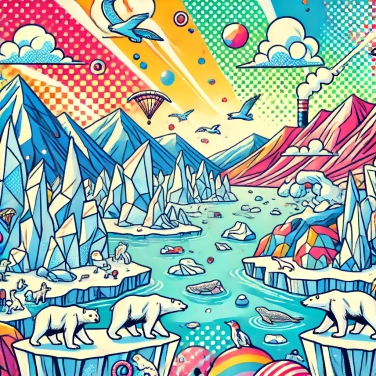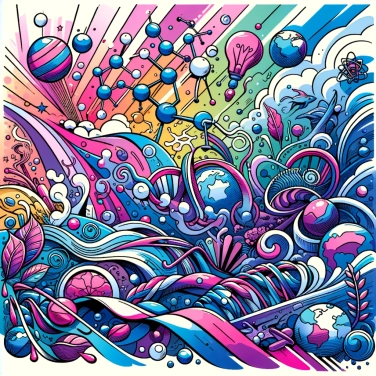Glaciers in Arctic regions are fragile due to climate change, which is causing ice melt and alterations in the balance of these ecosystems.

Arctic glaciers are very sensitive to changes in the climate. Even a tiny warming is enough to trigger accelerated melting. These enormous masses of ice respond quickly to variations in temperature and precipitation. Warming alters the seasonal cycle: summers become warmer and longer, winters less cold, preventing glaciers from recovering the lost ice. This disruption of the climate throws their natural balance out of order, quickly leading to their weakening. Ice does not forgive: the warmer it gets, the faster it shrinks and the less it resists new temperature increases.
The albedo effect corresponds to the ability of a surface to reflect sunlight. The lighter the surface, the more reflective it is. Glaciers, being very white, reflect up to 90% of solar rays back into space, thus preventing a lot of heat from being absorbed. But when they melt, they give way to darker water that reflects almost none. The direct result: more heat is absorbed, it gets warmer, and it's a vicious cycle that further accelerates melting. This feedback loop rapidly worsens the fragility of glaciers, especially in Arctic regions that are already sensitive to climate change.
Arctic glaciers react significantly to changes in ocean currents. When the oceans warm up, they directly erode the base of coastal glaciers, accelerating their melting. Similarly, unusual atmospheric temperatures also play a crucial role: warmer air leads to surface melting, further weakening the ice. Even modest variations in atmospheric winds can bring more warm water to the poles, exacerbating ice loss. Ultimately, when the ocean and air work together a bit too much, glaciers suffer, and their natural balance becomes seriously compromised.
Our human activities are causing a real mess at the North Pole. The combustion of fossil fuels emits a lot of greenhouse gases, intensifying global warming and leading to accelerated melting of Arctic ice. When we release carbon dioxide or methane into the atmosphere due to our cars, industries, or intensive agriculture, we quickly warm the air and the ocean around the glaciers. Air pollution, particularly soot particles from combustion, also settles on the ice and darkens its surface: as a result, there is less reflection of sunlight and more melting. The exploitation of natural resources such as oil, minerals, or gases, and the increasing tourism in these fragile areas, further disrupt the ecological balance. All of this combined means that the glaciers up there are weakening at a rapid pace.
The rapid melting of Arctic glaciers causes an accelerated rise in sea levels, directly threatening many coastal areas around the world (yes, your vacation beach too). With this rapid elevation, coastal erosion is gaining ground, literally encroaching on some inhabited lands. Another serious consequence: the disappearance of glaciers completely disrupts local ecosystems, forcing several species (polar bears, seals, walruses…) to migrate or struggle drastically for their survival. And of course, when the ice melts, it releases methane into the atmosphere, trapped in frozen soils for thousands of years, further exacerbating climate change. This is how a small glacial issue quickly becomes a major global headache.
An iceberg can be up to eight times larger below the surface of the water than what is visible to the naked eye. This is why the appearance of icebergs is misleading and poses a real danger to ships.
Permafrost, the frozen ground typical of the Arctic that remains frozen year-round, contains a vast amount of carbon that has been trapped for thousands of years. Its thawing could release this carbon in the form of greenhouse gases, further accelerating climate change.
The Arctic ice reflects approximately 80% of solar rays due to the albedo effect. When this ice melts, the exposed ocean absorbs more solar heat, further intensifying the melting process: a vicious climate cycle that is difficult to contain.
The Jakobshavn glacier in Greenland is considered one of the fastest glaciers in the world, moving towards the sea at a speed of over 40 meters per day!
Although it is impossible to immediately stop the melting of glaciers, measures such as drastically reducing greenhouse gas emissions, making significant investments in renewable energy, promoting policies to preserve polar regions, and raising public awareness can greatly contribute to slowing down the melting and minimizing its long-term global impact.
The accelerated melting of Arctic glaciers is causing a rise in global sea levels, threatening local marine and terrestrial ecosystems, altering global ocean circulation, and leading to more frequent extreme weather events. These effects, although initially concentrated in polar regions, are gradually extending to the entire planet.
Human activities primarily influence glacier melting through the emission of greenhouse gases that disrupt the global climate. The exploitation of natural resources in the Arctic, industrial pollutant emissions, and the constant increase in maritime transport activities significantly contribute to accelerating glacier melting.
The albedo effect refers to the ability of a surface to reflect solar radiation. Glaciers, due to their pristine white color, have a high albedo that allows them to reflect a large amount of sunlight. When glaciers melt, their white surface diminishes, exposing the darker water or soil beneath, which absorbs more heat, further accelerating the melting process.
Arctic glaciers are experiencing an acceleration of climate warming that is more pronounced than the rest of the globe, a phenomenon known as Arctic amplification. This acceleration is primarily due to the decreased albedo effect caused by ice melting, as well as significant changes in regional oceanic and atmospheric currents.

No one has answered this quiz yet, be the first!' :-)
Question 1/5